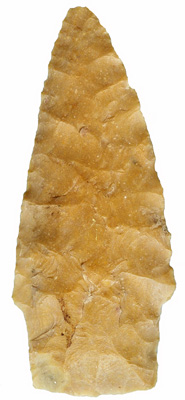

Point Type:
SCOTTSBLUFF
Also See: Eden, Hardin, Holland, Hollenberg Stemmed, Stone Square
Stemmed
Location: Midwestern to Eastern United States
Associated Dates: 10,000-8,000 B.P. - Transitional
Paleo
Morphology: Stemmed
General Description: The Scottsbluff
point is a medium to fairly large sized point that has straight to convex blade edges and a rectangular stem. The shoulders are weak and angular. The
stem may be straight to slightly expanded. The basal edges
are straight to slightly convex. The stem edge
is commonly ground. The Western Scottsbluff points tend
to have parallel flaking; whereas
the South-Central Scottsbluff points are usually randomly flaked
.
The Scottsbluff point type have been found from
West-Central Canada and the Rocky Mountains to the eastern woodlands fringe
and as far northeastward as Wisconsin. One was found in St. Charles
County, Missouri near St. Louis and they have been recovered as far south as
northwestern Louisiana, southwestern Arkansas, Texas and Oklahoma. The
wide distribution of this type, from Texas to Canada suggests considerable
antiquity which is supported by radiocarbon dating. The high quality of
workmanship, however, suggests a specialization that must have had its origin
elsewhere, possibly from Archaic stemmed forms in the Mississippi
Valley.
Wormington (1957) suggests that the Scottsbluff type can be
subdivided into two sub-types. The Type I and the Type II.
The Type I tend to be longer, thicker in cross section and with weakly
defined shoulders. The stem being formed more by heavy basal grinding
than by chipping. These Type I Scottsbluff points have been given
names such as the "First View" and "San Jon".
The
Type II
tends to be shorter and wider, thinner in cross section and with more
clearly defined shoulders. The Type II is more triangular in
shape and has a more definite stem and the blade has a lenticular
cross-section as opposed to the diamond shaped cross section often seen in
the Type I. Scottsbluffs of the Type II found in Missouri and
Illinois often have slightly to marked expanding stems with even more
pronounced shoulders. These particular points are probably the latest in
the series and demonstrate the evolutionary state between the earlier
Scottsbluffs to the later Hardin points.
Wormington also suggests that the Scottsbluff point be
assigned to the Cody complex
as
represented at the Horner site near Cody, Wyoming. At this site the
Scottsbluff point was found in association with the Eden point type and the Cody
knife form. Bison remains were present at the sites that the Scottsbluff
was found.
Bell states: " the Scottsbluff point represents some of the
finest lithic workmanship to be found in the New World. The quality of
chipping often supplies a clue to the identity, even in the case of artifact
fragments."
Perino states in his notes and comments: "These points are
related to the Midwestern variants known as Hardin Barbed points, the
Hardin having a greater basal variation and barbs. Both types display
exceedingly fine workmanship. Scottsbluff point from the southern portion
of their range differ in basal configuration from the Plains type. There
have been found in the Southern Scottsbluff area nearly a dozen St. Charles
points of Scottsbluff manufacture, which had identical blade dimensions but with
Dovetail stems instead of rectangular stems. A relationship between the
Hardin points and the St. Charles point has been postulated."
The size
range of the Scottsbluff ranges from 50 mm to 130 mm in length with the average
size being 88 mm.
The Scottsbluff point type was named by E. H.
Barbour and C. B. Schultz in 1932 after a bison quarry site near
Scottsbluff, Nebraska.
About The Point Above (Shown Twice Size): The small Type I, Scottsbluff blade pictured at the top of this page, was found in Arkansas. The point is made from a beautiful tan and mustard colored flint which may be Cobden Chert. This blade is not the best example for the type as it is a knife form and not a projectile point. As such the shoulders on this specimen are not very well defined. The blade exhibits parallel flaking patterns and excellent workmanship. The point is slightly dulled through use wear and the left side of the blade edge shows retouch performed to resharpen, where as, the right blade edge is excurvate. The base is ground as are the stem sides. The base edge has been thinned by the removal of three to four short flakes per side which are clearly shown in the photo. Overall, the point measures 69 mm in length, is 29 mm wide across the barbless shoulders, and is only 7.3 mm thick in mid blade. The stem is 15 mm long and the base of the stem is 22 mm wide. The stem is 5.6 mm thick at mid stem. Catalog Number 153-245-D
References: Bell (1), Dragoo (4), Elder, Hranicky (1), Justice (1), Overstreet, Perino (1, 5), Waldorf
© Copyright 1997 - 2008 LITHICS-Net WWW.LITHICSNET.COM
Use your Browser's BACK Button to return to the LITHICS-Net Index.